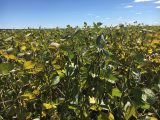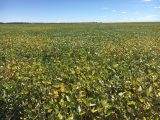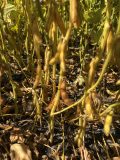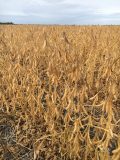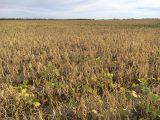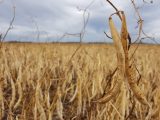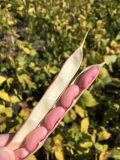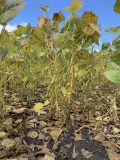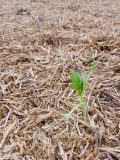 September 9, 2020
September 9, 2020
- Crop Update & Scouting Notes
- Impact of Fall Frost
- Dry Bean Harvest Tips
- Soybean Cyst Nematode
- Fall-seeded Pulse Cover Crops
- 2020 Pulse MRL Advisory
Listen to The Bean Report from September 1, 2020:
Crop Update
- Soybeans range from R6.5 (full seed/still green) to R8 (full maturity). This means harvest is right around the corner for early-seeded soybeans and early-maturing varieties. Most soybeans across MB are at R7, with yellowing leaves and pods. Recent cool, wet weather has slowed maturity. This week’s frost has affected soybeans at the R6.5-R7 stages.
- Dry bean harvest is underway for some market classes. Early yield reports are 2000 lbs/ac, on average, for pinto beans and 1800 lbs/ac, on average, for small red beans. Remaining edible bean crops range from R8 (beginning maturity) to R9 (full maturity). Black beans were swathed or desiccated late last week in anticipation of frost. Dry beans in western MB at R8 have been affected by the frost.
- Field pea harvest is wrapped up in most areas of the province, with only a few later-seeded acres remaining. The pea “cover crop” from harvest losses is at V2.
- Faba bean harvest is beginning as crops now reach full maturity.
Scouting Notes
- Right now it’s easy to identify white mould in soybeans and dry beans by the presence of bleached stems. Cut stems open to look for sclerotia bodies.
- Bacterial blight lesions are commonly found on dry bean pods at this stage. Open up pods and examine the seed to determine the severity of infection.
- Other diseases can be easily spotted in pulse and soybean crops but infection at this late stage should no longer pose a threat to yield.
- Soybean maturity ratings are underway at our regional variety trial locations and we are currently seeing a wide range in maturity.
Impact of Fall Frost
Hard freezing temperatures (<-1°C to -5°C) occurred on September 8 from the western edge of central MB, following the escarpment and through western Manitoba. Patchy, light freezing temperatures were reached in the Interlake and surrounding Winnipeg area. Light freezing temperatures were reached agaion across much of southern Manitoba on September 9, with the odd location recieving a hard frost.
The impact of frost on a crop depends on how low temperatures get, how long freezing temperatures last and the development stage of the crop, among other factors. Assess crops 24-48 hours after the frost event has occurred.
Soybeans at R6 to R7 and edible beans at R8 are susceptible to frost damage. Many soybean and dry bean crops in MB have reached maturity levels that are safe from frost. However, later-seeded fields and longer-season varieties that are still green are susceptible to damage.
Dry Bean Harvest
- Harvest dry beans at 16 to 18% seed moisture.
- Dry beans can successfully be harvested by undercutting and windrowing, swathing or direct harvesting (straight combining).
Harvesting Tips to Improve Dry Bean Quality:
Tips to reduce soil and smearing:
- Screen kits at the header and under the feeder house will help eliminate soil.
- Windrowing beans that have been undercut will help remove any soil clinging to the roots.
- Increasing fan speed can help if the soil is dry.
- For soft, puffy immature beans, smearing can occur when the moisture combines with the soil entering the combine. Waiting until these beans dry down further in the field is one option, but if you can keep these beans from earth tagging, they will dry down normally in the bin.
- Using a conveyor mounted on the combine to unload can also help reduce smearing.
Tips to reduce splits and cracks:
- Reduce cylinder speed. Starting speeds range from 300 to 600 rpm depending on bean type and harvest conditions. Reduce speed in 100 rpm intervals until you see a noticeable difference in cracks.
- If this doesn’t work, try closing your concave to thresh beans out quicker. A more open concave will allow beans to flow further into the threshing system, interacting with the rotor and cracking beans.
- Install a wide-wire concave. This allows beans to flow through the concave faster.
- More material entering the combine through larger windrows or a wider cutting width will also help cushion beans.
- Harvest when plants are dry so pods open more easily as they move through the cylinder and concave. Harvesting damp plant material may not open as quickly, resulting in more cracks and splits.
Soybean Cyst Nematode
It’s not too late to scout for SCN! This pest was officially identified in MB in 2019 and we want to find out where it’s lurking.  Early detection and timely management are key in avoiding significant yield loss from this pest.
Early detection and timely management are key in avoiding significant yield loss from this pest.
Gently dig up soybean roots to look for tiny, lemon-shaped cysts in suspect areas of the field, such as field approaches or low spots. The cysts will be much smaller than root nodules. Depending on your soil type, you may need a bucket of water to soak the roots to avoid breaking off any potential cysts.
If you think you have found SCN in your field, collect samples and contact Cassandra or Laura.
On-Farm Network Update
The On-Farm Network team is busy wrapping up data collection for the season! We have been working away at late season plant counts in our row spacing and population trials. Widening row spacing while maintaining target population, or increasing target population while maintaining row spacing, have the same effect – increasing the number of plants per row. This can lead to increased plant-to-plant competition within the row, the effects of which can be seen in the image below. Increased competition early in the season could lead to a decline in plant stand, which we assess with our late season plant counts.

Trial harvests are ongoing, and we are working away at putting the data together for the single page reports which will come out later this year! If you are interested in past OFN results visit https://www.manitobapulse.ca/on-farm-network/on-farm-research-reports/ to learn more.

Consider Fall-seeded Pulse Cover Crops
- Peas, lentils and faba beans are absent from most farm rotations, but there is an opportunity to incorporate these pulses as cover crops as they are:
- higher N producers than soybeans or dry beans,
- relatively frost tolerant (-4 to -6),
- have a shorter growing season, and
- seed is relatively easy to source locally.
- Research in MB has found that an acceptable level of biomass can be achieved with less that eight weeks from seeding to killing frost. More biomass generally means more N production.
- Peas produced greater and more consistent levels of biomass compared to lentils. Faba beans have not been tested, but they have great potential as they are the most frost-tolerant and highest N-fixer of the pulses.
- With winter cereal harvest wrapping up in the first and second week of August, and an average first frost date of the third or fourth week of September, these pulse cover crops would have roughly six to eight weeks to grow and accumulate biomass.
A Note on Balancing P and K Nutrient Budgets
- The P and K removed with harvested soybean seed is high and there is a limited crop capacity to tolerate seed-placed fertilizers.
- Early harvest allows time for a large addition of P and/or K fertilizer or manure in the fall.
- For example, in a soybean-canola-wheat rotation (yielding 40, 50 and 60 bu/ac, respectively) over thee years we would require approximately 140 lbs P2O5/ac to match the P removed. You could apply 100 lbs P2O5/ac in the fall, reserving an application of 20 lbs P2O5/ac as starter fertilizer for both the canola and wheat crops, which are more likely to respond to seed-placed P fertilizer than soybeans.
- This one-time P application should be incorporated, or banded, to reduce nutrient losses due to surface run off. This fertilization strategy would maintain soil fertility over the course of the rotation, saving time and cart space during seeding.



